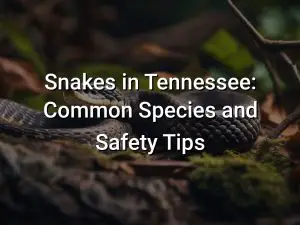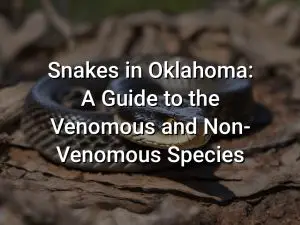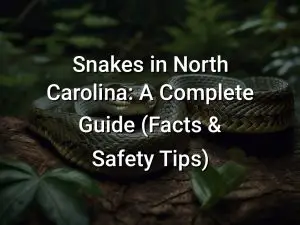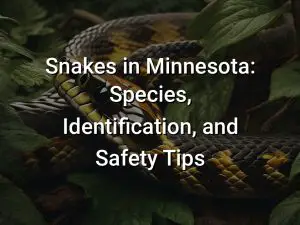Snakes in Kentucky: A Guide to Identification and Safety
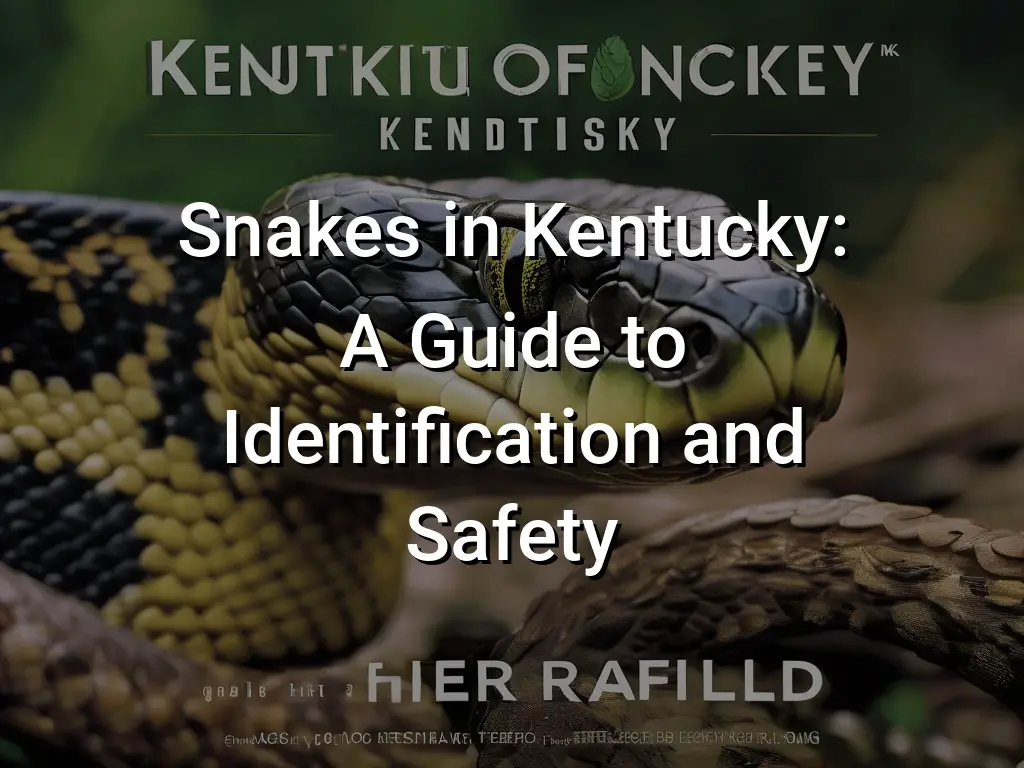
Snakes may not be everyone’s favorite creature, but they play an important role in Kentucky’s ecosystem. From the venomous Copperhead to the colorful Scarlet Kingsnake, Kentucky is home to a diverse range of snake species. In this guide, we’ll provide you with essential information on the identification and safety measures to help you navigate through encounters with snakes in the Bluegrass State.
While encountering a snake may be an unsettling experience for many, it’s crucial to understand that most snakes in Kentucky are non-venomous and harmless. However, to ensure your safety and the well-being of the snakes, it’s important to be able to identify different species and understand how to coexist with them in their natural habitat. So, let’s delve into this guide where we’ll explore the various snake species found in Kentucky and provide you with valuable tips on how to stay safe in snake-prone areas.
Quick Links
Introduction
Snakes are a common sight in Kentucky, and while many are harmless, it’s important to be able to identify the venomous species to ensure your safety. This guide will provide you with information on the various snakes found in Kentucky, their identification features, and safety tips for encountering them. By familiarizing yourself with the different snake species, you can better navigate and appreciate the diverse wildlife of Kentucky while staying safe.
Copperhead
The copperhead is a venomous snake that is commonly found in Kentucky. It gets its name from the coppery coloration of its head and body. Copperheads are relatively small snakes, typically measuring between 2 and 3 feet in length.
Identifying features of a copperhead include a triangular-shaped head, vertical pupils, and a series of dark, hourglass-shaped bands on its body. The coloration of copperheads can vary, but they typically have a tan or light brown base color with darker bands.
Copperheads are primarily found in wooded areas, including forests, fields, and rocky hillsides. They are excellent climbers and can often be spotted sunning themselves on rocks or low branches. Copperheads are most active during the warmer months, from April to October.
When encountering a copperhead, it is important to exercise caution. Do not approach or attempt to handle the snake, as they can deliver a painful and potentially dangerous bite. If you see a copperhead, give it a wide berth and allow it to move away on its own.
If you are bitten by a copperhead, seek immediate medical attention. Symptoms of a copperhead bite can include pain, swelling, and discoloration around the bite area, as well as nausea, weakness, and difficulty breathing.
Overall, it is important to be aware of the presence of copperheads in Kentucky and to take appropriate precautions when exploring natural areas. By staying alert and respecting the snakes’ space, you can enjoy the beauty of Kentucky’s wildlife while staying safe.
Eastern Rat Snake
The Eastern Rat Snake, also known as the Black Rat Snake, is a non-venomous snake species found in Kentucky. It is one of the largest snake species in the state, reaching lengths of up to 6 feet.
The Eastern Rat Snake has a black or dark brown body with a white or cream-colored belly. Juveniles may have blotches or patterns on their bodies that fade as they grow older. They are excellent climbers and are often found in trees and tall vegetation.
Despite its name, the Eastern Rat Snake primarily feeds on small mammals, birds, and eggs, rather than rats. It plays an important role in controlling rodent populations in its habitat.
While the Eastern Rat Snake is not venomous, it can bite if it feels threatened. However, they are generally non-aggressive and will typically try to escape rather than confront humans. If you encounter an Eastern Rat Snake, it is best to give it space and observe it from a safe distance.
If you have a rat problem on your property, having an Eastern Rat Snake around can be beneficial. They are natural predators of rodents and can help keep their populations in check. However, if you are uncomfortable having snakes near your home, it is best to contact a professional who can help safely remove them.
Remember, snakes are an important part of the ecosystem and should be respected and protected. Most snake encounters are harmless, but it is always a good idea to educate yourself about the different snake species in your area to ensure your safety and the well-being of these fascinating creatures.
Western Cottonmouth
The Western Cottonmouth, also known as the Water Moccasin, is a venomous snake commonly found in Kentucky. It is one of the only venomous snakes indigenous to the state and is known for its aggressive behavior and potent venom.
The Western Cottonmouth is a relatively large snake, typically measuring between 2 to 4 feet in length. It has a thick, muscular body and a distinctive triangular-shaped head. The snake’s coloration varies but is typically dark brown or black with darker bands or blotches along its body.
As their name suggests, Western Cottonmouths are often found near bodies of water such as swamps, rivers, and lakes. They are excellent swimmers and are even known to bite underwater if threatened.
When confronted, the Western Cottonmouth will typically display aggressive behavior, such as opening its mouth wide to reveal its white, cotton-like interior. This behavior is a warning sign to potential threats to stay away.
The venom of the Western Cottonmouth is highly toxic and can cause severe injury or even death if left untreated. If bitten by a Western Cottonmouth, seek medical attention immediately.
To avoid encounters with Western Cottonmouths and other venomous snakes in Kentucky, it is important to take precautions when spending time in snake-prone areas. Wear sturdy footwear and long pants, watch where you step or reach your hands, and avoid tall grasses or brush where snakes might be hiding.
Remember, snakes play an important role in the ecosystem and are generally not aggressive unless provoked. If you encounter a snake, give it space and allow it to retreat without causing harm.
By being aware of the Western Cottonmouth and other snakes in Kentucky, you can safely enjoy the state’s natural beauty while minimizing the risk of snake encounters.
Eastern Kingsnake
The Eastern Kingsnake is a non-venomous snake species found in Kentucky. It is known for its distinctive coloration, with a black body and yellow or white bands that form a chain-like pattern along its back. The Eastern Kingsnake can grow up to 4-6 feet in length.
This snake species is a constrictor, meaning it subdues its prey by coiling around it and squeezing until the prey becomes immobilized. Eastern Kingsnakes primarily feed on small rodents, birds, and reptiles, including venomous snakes like copperheads and rattlesnakes.
Despite its ability to eat venomous snakes, the Eastern Kingsnake is harmless to humans. It is not aggressive and will usually try to escape when encountered. However, if cornered or threatened, it may hiss, vibrate its tail, and strike. It is important to keep a safe distance and avoid provoking the snake.
The Eastern Kingsnake is beneficial to the ecosystem as it helps control populations of rodents and other small animals. It plays an important role in maintaining a balance within the natural environment.
If you encounter an Eastern Kingsnake in Kentucky, it is best to appreciate it from a distance and allow it to go about its natural activities. Do not attempt to handle or disturb the snake, as this can lead to stress or injury for both the snake and yourself.
Timber Rattlesnake
The timber rattlesnake is a venomous snake species found in Kentucky. It is the largest venomous snake in the state and is known for its distinctive rattle on the end of its tail. The timber rattlesnake is typically found in forested areas with rocky outcrops, as these habitats provide suitable cover and hunting opportunities.
When it comes to identification, the timber rattlesnake has a brown or grayish-brown body with dark bands or chevron-shaped patterns along its entire length. The tail is typically black with yellow or grayish bands. The rattle on the end of the tail is made up of segments that produce a distinctive sound when vibrated, serving as a warning to potential threats.
Encountering a timber rattlesnake in the wild can be a dangerous situation, as the snake’s venom can cause serious harm or even death. It is important to exercise caution and give these snakes their space. If you come across a timber rattlesnake, slowly back away and leave it undisturbed.
It is also worth noting that timber rattlesnakes are a protected species in Kentucky, and it is illegal to kill or harm them. They play a vital role in the ecosystem by controlling rodent populations, and efforts are being made to conserve their habitats.
If you believe you have encountered a timber rattlesnake or any other venomous snake in Kentucky, it is best to contact local authorities or snake removal experts who can safely handle the situation. It is essential to prioritize safety and avoid unnecessary risks when it comes to dealing with venomous snakes.
Northern Water Snake
The Northern Water Snake, also known as Nerodia sipedon, is one of the most common snakes found in Kentucky. This non-venomous snake can be found near bodies of water such as rivers, streams, and ponds. It is known for its dark brown or gray coloration, with dark, blotchy patterns along its body.
The Northern Water Snake is often mistaken for the venomous Copperhead snake due to its similar appearance. However, there are key differences that can help you identify the Northern Water Snake. Unlike the Copperhead, the Northern Water Snake has a round eye and lacks the distinctive hourglass-shaped markings on its body.
Although the Northern Water Snake is non-venomous, it can be aggressive and may bite if it feels threatened. It is important to give these snakes their space and avoid provoking them. It is also important to note that the species is protected by the state, so it is illegal to kill or harm these snakes.
When encountering a Northern Water Snake, it is best to observe it from a distance and not attempt to handle it. If you encounter one while swimming or boating, it is recommended to calmly move away from the snake. It is always a good idea to educate yourself about the various snake species in Kentucky to ensure your safety and the well-being of these animals.
Smooth Earth Snake
The Smooth Earth Snake is a small, non-venomous snake species that can be found in Kentucky. It is known for its smooth and shiny scales, which range in color from gray to brown. The Smooth Earth Snake is usually less than a foot long and has a slender body, making it difficult to spot in its natural habitat.
This snake species prefers to live in wooded areas with loose soil, such as forests, fields, and gardens. It is often found under leaf litter, rocks, or logs, where it hunts for small invertebrates, such as worms and slugs. The Smooth Earth Snake is harmless to humans and plays an essential role in controlling pest populations.
When threatened, the Smooth Earth Snake will try to escape or hide rather than confront its predator. It may release a foul odor or excrete musk as a defense mechanism. If handled, it may also attempt to bite, although its tiny teeth and lack of venom make its bite harmless.
Although the Smooth Earth Snake is not dangerous to humans, it is important to treat all snakes with caution and respect. If you encounter a snake in the wild, it is best to observe it from a safe distance and avoid disturbing its habitat. If you are unsure about the identification of a snake, it is always recommended to leave it alone and seek assistance from a knowledgeable expert.
Overall, the Smooth Earth Snake is a fascinating and harmless snake species found in Kentucky. By understanding and appreciating these snakes, we can cultivate a greater respect for the diverse wildlife that inhabits our state.
Ring-necked Snake
The Ring-necked Snake is a small and non-venomous snake found in Kentucky. It gets its name from the distinct yellow or orange ring around its neck. This snake is known for its vibrant colors and unique pattern, which can vary depending on its age and location.
The Ring-necked Snake is usually black or dark gray in color, with a bright yellow or orange underside. It has smooth scales, a slender body, and can grow to be around 10-15 inches long. While it may appear small and harmless, it is important to remember that all snakes should be treated with caution and respect when encountered in the wild.
This snake is primarily active at night and feeds on small invertebrates such as worms, slugs, and insects. It is commonly found in wooded areas, grasslands, and near water sources such as streams and ponds. The Ring-necked Snake is not aggressive and will typically try to hide or flee when encountered by humans.
When it feels threatened, the Ring-necked Snake may exhibit defensive behaviors such as curling its body, flattening its head, and releasing a musky odor. It is important to give this snake space and avoid handling it, as it may bite if it feels cornered or threatened.
If you come across a Ring-necked Snake in Kentucky, the best course of action is to observe it from a distance and appreciate its beauty. Take care not to disturb its habitat or provoke it in any way. Remember, it is illegal to harm or kill non-venomous snakes in Kentucky, as they play an important role in the ecosystem by keeping pest populations in check.
While the Ring-necked Snake is not venomous, it is always a good idea to familiarize yourself with the different snake species in your area and learn how to identify venomous snakes to ensure your safety. If you encounter a snake and are unsure of its identity or behavior, it is best to err on the side of caution and contact a local wildlife authority for assistance.
Black Racer
The Black Racer, also known as the Eastern Racer, is a non-venomous snake species that is commonly found in Kentucky. It is known for its sleek and shiny black coloration, which helps it blend in with its surroundings.
The Black Racer is a fast and agile snake, capable of reaching speeds of up to 10 miles per hour. It is often found in grassy or wooded areas, where it preys on small mammals, birds, and lizards.
Although the Black Racer is not venomous, it can be defensive and may bite if it feels threatened. However, its bite is generally harmless to humans and rarely requires medical attention.
If you encounter a Black Racer in the wild, it is best to observe it from a distance and avoid disturbing or provoking it. Remember to always respect wildlife and their habitats, and never attempt to handle or capture a snake unless you are trained to do so.
Overall, the Black Racer is an important and fascinating part of Kentucky’s ecosystem. By understanding and appreciating these snakes, we can coexist with them safely and promote the conservation of their natural habitats.
Scarlet Kingsnake
The Scarlet Kingsnake is a small and colorful snake native to Kentucky. It is known for its striking pattern of red, black, and yellow bands that encircle its body. The Scarlet Kingsnake is often mistaken for the venomous Coral Snake due to its similar coloration, but can be distinguished by its different band pattern.
These snakes are non-venomous and pose no threat to humans. They are secretive and generally prefer to avoid encounters with humans. Scarlet Kingsnakes are excellent burrowers and can often be found hiding under leaf litter or in rotting logs.
Scarlet Kingsnakes primarily feed on small reptiles, such as lizards and other snakes. They are constrictors, meaning they will subdue their prey by coiling around it and squeezing until it suffocates. They have a slow metabolism and can go for long periods without food.
As with all snakes, it is important to respect the Scarlet Kingsnake’s natural habitat and observe them from a safe distance. While they are not venomous, it is always best to avoid handling any wild snake without proper training and experience.
Scarlet Kingsnakes play an important role in the ecosystem by controlling populations of small reptiles. Their vibrant coloration also adds beauty to the natural landscape of Kentucky. If you are lucky enough to spot a Scarlet Kingsnake, take a moment to appreciate its unique and fascinating characteristics.
Northern Milk Snake
The Northern Milk Snake is a species of snake found in Kentucky and other parts of North America. It is a medium-sized snake, typically measuring between 2 and 4 feet in length. It has smooth scales and a slender body, with a triangular-shaped head. The coloration of the Northern Milk Snake can vary, but it typically has a light-colored background with dark blotches or bands. The belly is usually a light cream or yellow color with dark markings.
The Northern Milk Snake is primarily active during the night and is often found in wooded areas, grasslands, and rocky outcrops. It is a non-venomous snake, but it may bite if it feels threatened. The bite is not dangerous to humans and is usually only used as a last resort for self-defense.
One of the distinctive features of the Northern Milk Snake is its ability to mimic the appearance of the venomous Eastern Coral Snake. It has similar red, black, and yellow banding, but the pattern is different. This is a defense mechanism to deter predators.
The diet of the Northern Milk Snake primarily consists of small rodents, such as mice and voles, as well as other small animals like birds and amphibians. It is a constrictor and will suffocate its prey before swallowing it whole.
When encountering a Northern Milk Snake in the wild, it is important to remember that it is a harmless snake and plays a beneficial role in controlling rodent populations. If you come across one, simply observe from a distance and do not attempt to handle or harm it. Like all wildlife, snakes should be respected and left undisturbed in their natural habitat.
Conclusion
Snakes are a common sight in Kentucky, and it’s important to be able to identify them and understand the necessary safety precautions. By familiarizing yourself with the different species found in the state, such as the Copperhead, Eastern Rat Snake, Western Cottonmouth, Eastern Kingsnake, Timber Rattlesnake, Northern Water Snake, Smooth Earth Snake, Ring-necked Snake, Black Racer, Scarlet Kingsnake, and Northern Milk Snake, you can better navigate encounters with these reptiles.
Remember, snakes play an important role in the ecosystem, and most of them are harmless and non-aggressive. However, it’s always wise to maintain a safe distance and avoid handling them. If you do encounter a snake, stay calm and slowly back away. By respecting their space and practicing caution, you can coexist with these fascinating creatures in the great outdoors of Kentucky.

